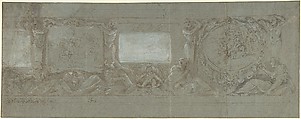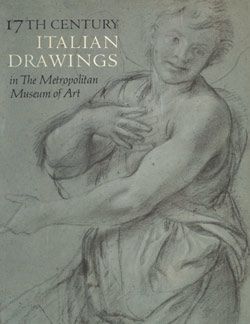Design for a Wall Decoration with the Sacrifice of Abraham and the Flight into Egypt
Giovanni Lanfranco Italian
Not on view
A pupil of Agostino and Annibale Carracci, Lanfranco worked in Rome early in his career, in Piacenza, in Rome again from 1612 to 1634, and finally in Naples. The artist made this fluid and graceful drawing in preparation for the fresco decoration of the Sala Regia in the papal Palazzo del Quirinale, a commission from Pope Paul V on which Lanfranco worked in 1616–17 along with Agostino Tassi, Carlo Saraceni, and others.
Erich Schleier (1970) related this drawing to the project for the decoration of a section of the frieze in the Sala Regia of the Quirinal Palace in Rome and identified it as the design for a section of a decorative frieze on the end wall of this important hall - a large room of the Swiss Guard in the Quirinal (also known as Sala de' Svizzeri and Sala de' Corazzieri). This end wall gives access to the Pauline Chapel, frescoed by Michelangelo around 1546. Previously given to Giovanni Lanfranco and Matthäus Terwesten (1670-1757), the attribution of the sheet to Lanfranco was suggested by Dr. A. von Wurzbach. Later, Dr. K. G. Boon attributed it to Matthäus Terwesten (see here "References": Boerner 1966 and Boerner 1968). When the drawing was put on sale by Hauswedell in Hamburg in 1966, Erich Schleier recognized its connection with the frieze in the Sala Regia, thus confirming the traditional attribution to Giovanni Lanfranco written on the verso ("ducati 2 - / Lanfranco.")
The rectangular frames, clearly designed for windows, appear on the Metropolitan Museum of Art's drawing as they do in the Sala Regia, that is immediately below the upper cornice of the frieze. On the left, between two windows, is the scene of the ‘Sacrifice of Isaac.’ This scene designed to be represented as on a tapestry, was intended as the actual center of the finished design. The allegorical figures surrounding the Sacrifice of Isaac are probably Virtues. On the right is the narrative scene of the Flight to Egypt.
The decorations of the Sala Regia were completed in several stages, but the entire fresco was finished by 1616. The artists Agostino Tassi, Saraceni and Giovanni Lanfranco are known to have worked in the Sala Regia during the pontificate of Paul V Borghese (1605-1621) and probably shared common portions of the walls during the executions of the paintings. Lanfranco's hand can be distinguished in large portions of the frieze on the two end walls of the ‘Sala.’ His work there is well documented by extant drawings. These drawings have retained the artist's original, well-conceived design for the short walls, which, for unknown reasons, was considerably altered. In the finished frieze, structurally less important elements were taken over from the main walls, e.g. the real window frames, clearly visible on the Metropolitan Museum of Art's drawing and the drawing in the Abrosiana (see below) were substituted by imaginary balconies - a derivation from the main walls.
The scene of the ‘Sacrifice of Isaac’ originally decorated the center of the end wall giving access to the chapel. It was destroyed before 1619, less than three years after it had been painted, to make room for Landini's tympanum and the pediments over the doorway. The original fresco is mentioned by the biographer Giovan Pietro Bellori (Le Vite de' Pittori, Rome, 1672, p. 369) as follows: "Facendo il Potefice Paolo V, dipingere il Palazzo di Monte Cavallo, nel fregio della Sala Regia fù distrubuita al Lanfanco la Storia di Mosè che cangia la verga in serpente, e l'altra di Abramo che sacrifica il figliuolo Isac, accompagnate da figure, e da Virtù et ornamenti".
Two other composition drawings for sections of this frieze and several studies for the individual figures have been identified. One composition drawing is in the Musée du Louvre, Paris (discussed and reproduced in Walter Vitzthum, ‘A Project by Lanfranco for the Quirinal,’ in The Burlington Magazine, vol. 106, no. 734, 1964 (May), pp. 216 ff., pl. 29), another one is in the Biblioteca Ambrosiana, Milan (discussed and reproduced in Walter Vitzthum, op. cit., pp. 216 ff., pl. 30). The Louvre drawing was wrongly attributed to Pierfrancesco Mola by Mariette. Walter Vitzthum recognized that it is by Lanfranco (see Walter Vitzthum, op. cit., p. 216). The Louvre's drawing shows the papal coat of arms, of which only half is visible (on the left). The coat of arms appears in precisely this way in the frieze of the Sala Regia, where the arms of Paul V Borghese used to decorate the corners, half appearing on the end walls and half on the main wall.
The Ambrosiana drawing shows the scene of the ‘Sacrifice of Isaac’ in the center. The drawing represents two variant solutions for the corners which were either to be decorated with half of a papal coat of arms, as on the left, or with half of a medallion supported by a putto, as on the right. Just as the space below the opening for feigned windows could be decorated either with a roundel containing a bust (very likely that of Paul V) or with an eagle as represented on the right, no doubt to be balanced by the Borghese dragon on the left, should this half of the design be adopted for the execution.
Erich Schleier (‘Lanfranco's 'Notte' for the Marchese Sannesi and some early drawings,’ in The Burlington Magazine, vol. 104, no. 711, June 1962, pp. 255-56) describes and reproduces the following studies for the individual figures appearing on the frieze: Study for a Justitia in the Biblioteca Ambrosiana, Milan (pl. 28); Study for a Putto in the Gabinetto dei Disegni, Uffizi, Florence (pl. 26) and a study for the figure of Moses, for the oval The Staff of Moses turning into a Snake on the opposite side of the rom (pl. 32). H. Hibbard (in Miscellanea Bibliothecae Hertzianae, Vienna, 1961, p. 359, no. 23) describes a chalk study for one of the caryatids on the frieze in the Sala Regia. The drawing is at Windsor Castle, no. 5701 (reproduced, A. Blunt and H. L. Cooke, The Roman Drawings, London, 1960, pl. 5).
(Carmen C. Bambach)
Due to rights restrictions, this image cannot be enlarged, viewed at full screen, or downloaded.





